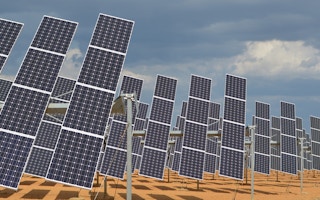Solar energy technology is not new and has been used in a wide variety of ways, from providing energy through microgrids in remote areas, to solar powered cars and cell phone chargers.
Solar has also been used in the agricultural sector for some time, providing clean energy for irrigation, crop preservation, and even desalinisation. For instance in India, some state governments have been promoting the use of solar power for irrigation pumps for many years using agricultural subsidies.
In the past, the hefty price tag for solar panels and the expertise needed to operate them kept the technology out of reach for the majority of smallholder farmers in the developing world.
But now, as the technology has advanced and producers are vying for market dominance, the price of solar technology has dropped dramatically, making this source of clean energy available to an ever growing percentage of society.
As a result, the use of solar technology in agriculture is increasing at breakneck speed, a trend that has the potential to reduce greenhouse gas emissions in a sector notorious for its propensity to pollute. It also means that farmers who have been paying for diesel or electricity provided by utility companies to irrigate crops and water livestock now have access to a green source of energy that, after the initial investment, is virtually free.
People are taking notice, from private companies providing solar pumping systems, to public sector organisations like the World Bank and GIZ, all of whom have an interest in implementing this technology to provide sustainable and reliable access to energy and working on this agricultural innovation. Recently, representatives from public and private sectors met at FAO to talk solar tech, financing, challenges and opportunities in this growing field.
So is solar a win-win?
Solar tech in agriculture is a positive advancement, and helping to make it available to small and medium holder farmers will improve the environmental sustainability of farming, while also improving livelihoods.
That’s not to say there aren’t opportunities to do some things better.
When it comes to solar powered irrigation, moving surface water is a no brainer, where the technology fits the need, all while decreasing pollution and drudgery. However, participants at the meeting were concerned about groundwater depletion if use of solar energy for extraction is not regulated. Governance of groundwater is generally poor, and if solar electricity is perceived as being free, there is a risk that farmers will overuse this critical resource.
IWMI and WLE already have some experience dealing with this issue, particularly in Western India, where the groundwater resource is particularly taxed. Researchers have worked to create incentives for farmers here to use solar powered pumps responsibly, but more needs to be done to understand the larger implications on the precious groundwater resource.
Another issue is suitability. Solar powered irrigation can be used for pumping both surface and groundwater, but not all locations have the same access to water, or even an efficient terrain for moving it.
IWMI researchers have developed suitability maps for some countries in Africa, including Ethiopia, where factors like groundwater and surface water availability, slope, and rainfall are taken into accounted for. These maps show how appropriate solar technology is for a given location, giving those who wish to invest in the technology a stronger evidence base for decision making. There are plans to create these maps for more countries in Africa and eventually Asia, dependent on demand and urgency.
In addition, renewable groundwater availability for irrigation has been mapped for Africa, which would also provide evidence for where to invest in groundwater pumping, and where there will be limited returns on investment.
Finally, while solar is heavily subsidised by many governments aiming to lower greenhouse gas emissions in order to achieve national and international emission goals, the financial longevity of the technology hinges on financing and economic viability of solar ventures. Participants discussed the possible financing options, both in terms of expanding the technology to far reaching places, but also to ensure social equity, making sure the poorest farmers don’t lose out.
“
Solar technology for agriculture is a positive development, especially if it can be developed in a way that is sustainable and equitable.
IWMI has worked on a business model for solar irrigation in Ethiopia, outlining the financial and institutional mechanisms that need to be taken into account in order to make solar accessible to small and medium scale farms. These business models look not only at environmental sustainability, but financial and social sustainability and inclusivity as well. By considering different mechanisms of adoption, payment, financing, and governance, the models lay out how to make access to solar technology more inclusive, especially for the poorest farmers, so that no one is left behind. Dealing with social and economic disparity is a major focus of the solar implementation work, there are plans to create similar business models for Ghana and Mali in the near future.
What did we learn?
Ultimately, solar technology for agriculture is a positive development, especially if it can be developed in a way that is sustainable and equitable. Both the private sector and research organisations have an interest in supporting the growth of solar, albeit for slightly different reasons. Some things to keep in mind:
Context is important. Not all pumps or solar panels will work in all places, and the social and environmental effects of technology will be different from place to place. Knowledge is therefore essential to develop this technology and support farmers and decision-makers in targeting investment.
Equity is important. Solar technology, like any technology, is not gender or age neutral. Given that opportunities are not equal for all parties, implementation must take the needs of all users, including women and youth, into account if it is to be the catalyst of real social and economic change.
Capacity development is important. People obviously need to be trained if they are to use the technology in a way that is beneficial and creates new opportunities for their farms and futures. But capacity building in terms of efficient use and environmental impacts is equally important, and providing this information in a way that is accessible is good for the earth and for development.
Partnerships are important. Private businesses have already a presence and are selling solar technology without help from the public sector, but most companies are interested in further incorporate environmental and social considerations into their technology. Managing the use of solar technology to irrigate is something that we can work together to explore further, from exploiting the built-in limitations of solar – i.e. hours of sun exposure – to remotely controlling pump with smart management systems. These capacities can be used by managers and decision-makers to better understand groundwater resource use and abstraction, and help private companies improve the functionality of their technologies. With good private public partnerships that don’t pit us against them, we can improve decision making around solar irrigation while contributing to rural development and growth, all without compromising our shared values.
As researchers committed to improving rural development, we are an important partner in the expansion of solar technology. We can provide answers on how to make an already great technological and social innovation better, and help fill knowledge gaps that still exist. By providing an evidence base and working with our fellow practitioners and farmers, we can help make the use of solar technology better, heralding a brighter future for all.
Mia Signs is a communications officer with Water, Land and Ecosystems. This post is republished from the WLE Thrive Blog.











